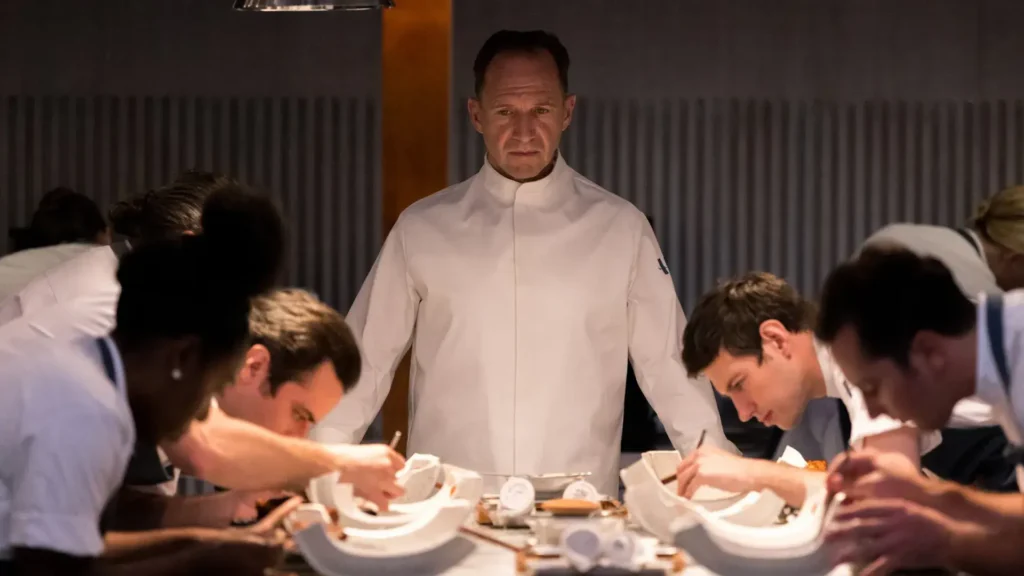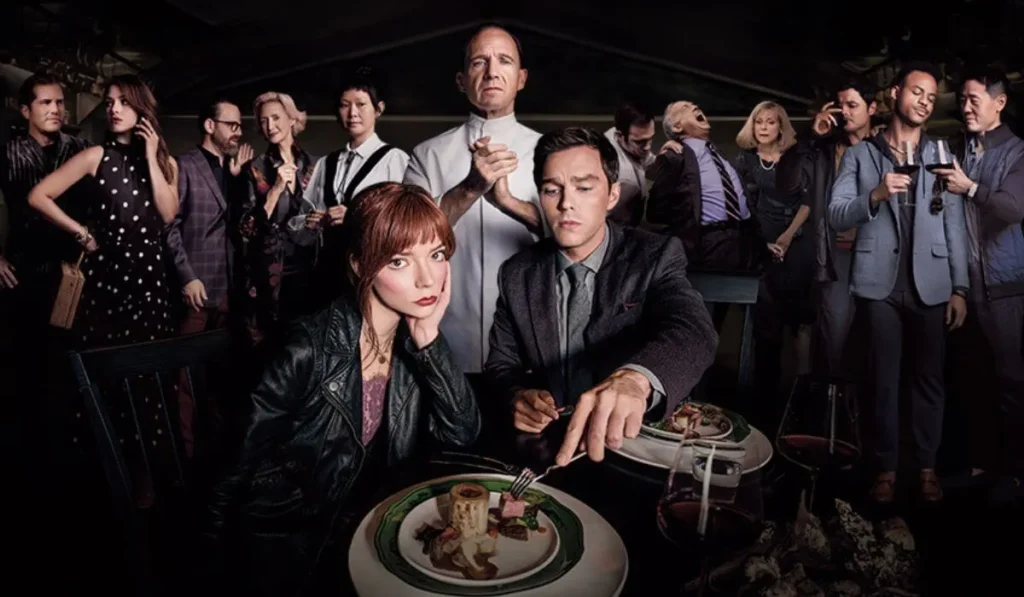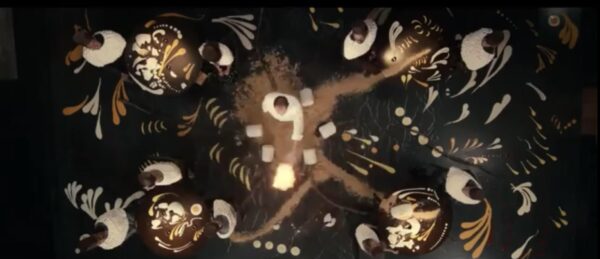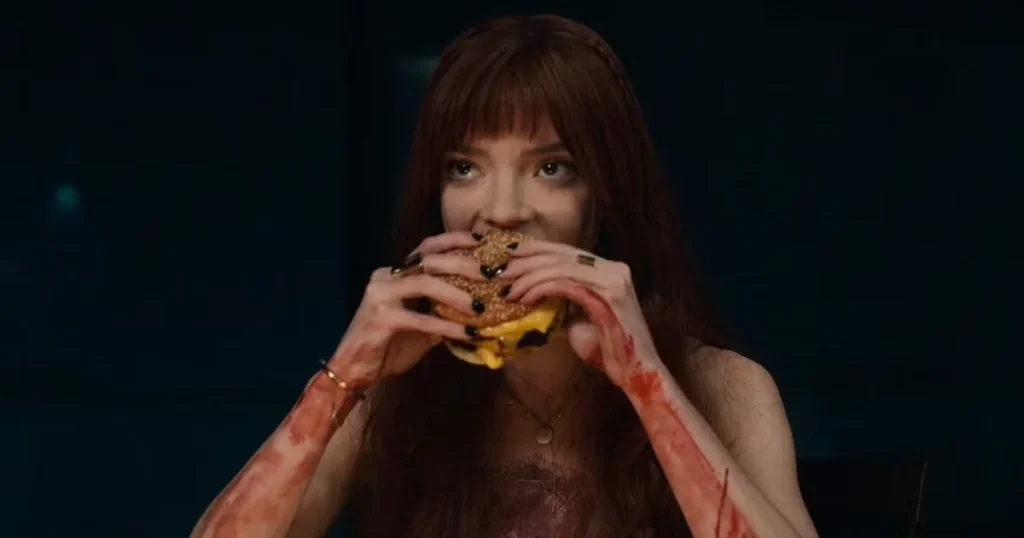If you walked out craving a greasy burger and a rant about class, same! The Menu ending doesn’t just torch a dining room, it skewers the whole system that turns passion into product and chefs into brands. Beneath the gels and tweezers is a sharper question, who gets to enjoy art, who strips it hollow and what happens when a cook remembers why the stove mattered. The Menu lands like a dark joke with a soft center, all because it pivots on something as ordinary as a cheeseburger.
Here’s what we’ll unpack, the cheeseburger request and why it unlocks the kitchen door, the s’more inferno and its bonfire of vanities symbolism, how class and authenticity drive every course, why Margot walks away while the elites melt, what Chef Slowik is really staging and the meaning of that last bite on the boat. Short version: simple food, big statement and no crumbs left.
The Last Course That Saves a Life

By the time we reach The Menu ending, Chef Julian Slowik (Ralph Fiennes) has staged a full-on ritual disguised tasting menu. The guests which include critics, tech bros, a fading movie star, a superfan, they all aren’t really diners so much as exhibits. Every course humiliates them, educates them or both. Then Margot (Anya Taylor-Joy), the only person who wasn’t on the reservation list and the only one who refuses to play disciple, changes the temperature in the room. She asks for a cheeseburger.
It sounds like a joke, but it’s the smartest order in the movie, the request cuts through the rules of performance and forces Slowik to cook, not present. The Menu pivots right there: a simple burger becomes a time machine to the chef’s first spark—before investors, before celebrities, before the nightly sermon.
Why the Burger Works (And the Other Courses Don’t)
While Slowik was trying to bring Margot to his team, he required a barrel in the preparation of his last dish. While Margot gets him the barrel, she somehow manages to get access to the silver door. Behind that door she finds that Slowik was once young and was making cheeseburgers.
When she’s back, she tells Slowik that she is hungry and needs to order a cheeseburger with fries. Slowik’s haute cuisine has become homework. But the cheeseburger was like recess to him. He grinds, sizzles, flips and plates with concentration of a person who suddenly remembers joy. Margot takes a bite, likes it and says it’s good. But as she is satiated from the meals she has already had, she does the most human thing in The Menu ending, she asks for it to go.
That tiny act, “Can I get this wrapped?” recognizes the chef as a person and not a cult leader and food as food, not a sermon. It also acts as her lifeline. He lets her leave with the takeout bag, granting her the only real kindness anyone receives all night. In a story about ownership and control, the ending of The Menu argues that authenticity is the only key that actually opens all doors.
Takeout as Jailbreak

Margot’s exit is not her sheer luck, it’s fluency. She actually reads the room and sizes up the chef and refuses to play along. No flattery, no buzzwords, no worship at his altar. In the end, the survivor is the one who treats Slowik as a human being with a craft. And also reminds him he is still skillful. The man running it all. She refuses to flatter him, refuses to praise him at all points in time. That quiet boat ride, burger in hand, lands like a wink and a victory lap, but it’s also a eulogy for what he lost, simple joys without performance.
Also, read Blink Twice Ending Explained: Memory Loops, Mind Games and a Paradise Gone Rotten
Dessert as a Funeral: The S’more Spectacle
With Margot gone, The Menu ending assembles everyone else for one last course: the s’more. Marshmallows become capes, chocolate tile becomes crowns; graham “crumbs” and ledgers feed the flames. It’s absurd and horrifying, like a campfire sing-along in hell. Slowik includes himself and his brigade in the blaze, because that restaurant isn’t just a workplace but a trap he built and then outgrew it. The ending burns the temple down because the faith is gone.
Also, the choice of s’more is cruelly perfect. It’s the most democratic dessert in America, kids, campfires, sticky fingers and here it’s repurposed as a bonfire of vanities. If the cheeseburger connected Slowik to craft, s’mores bury the culture that turned his craft into currency.
What Slowik Really Wanted (And What No One Could Give Him)

All night, Slowik demands “breadth of experience” and “proper respect”, but The Menu ending reveals he wants something smaller and harder: honesty. The superfan wants proximity. The critic wants power. The tech bros want status. Even the actor wants absolution. Only Margot gives him the straight line he’s starved for: feed me something because you love making it, not because I paid to admire it. The ending lets him taste that feeling once more and then closes the kitchen for good.
The Class Knife Under the Cloche
Beneath the deadpan comedy, The Menu is a furious tale about who gets to consume culture and how they treat the people who make it. The guests are not evil masterminds; they’re something worse for an artist, indifferent. They devour experiences without appetite, praise without taste, critique without care. Slowik’s revenge is theatrical, but his target is precise: the pipeline that turns living work into luxury packaging. The Menu ending doesn’t excuse his violence; it explains why the fuse was so easy to light.
Why Margot Lives When Everyone Else Doesn’t

Margot is not a foodie. She’s not rich. She’s not there to collect a story for Instagram. She’s a professional at reading needs and providing service, and the story lets her use that expertise better than any sommelier. She spots the wound, joy curdled by commerce and treats it with the only medicine that works: a sincere order and a clean plate. She’s also the only guest who meets the staff’s eyes, notices the burns, and refuses to cosplay gratitude. In a movie where performance kills, she wins by being stubbornly real.
Also, read The Little Things Ending Explained: Truth, Lies and Red Hair Clips
The Menu Ending as a Critique of the “Experience Economy”
The Menu’s ending takes a playful swipe at modern fine dining, the tasting menus, the velvet rope exclusivity, the “chef as spiritual leader” vibe. It shows how chasing trends can turn cooking into performance and diners into worshippers who pay in social clout. In the end, that simple cheeseburger is a quiet rebellion. It’s not rejecting skill, it’s reminding us that skill should serve real hunger and not an image. Here, authenticity has bite, cutting straight through all the pretension like a warm knife through soft brioche.
The Last Image: A Greasy Miracle
On the boat, Margot unwraps her burger, wipes her mouth with Slowik’s monogrammed menu, and eats. The Menu ending closes not on screams but on chewing—simple, animal, satisfied. It’s funny and a little sad. She survives, but she’s still dining on the night’s wreckage. Even so, the bite lands like a benediction: craft can still nourish when it’s made for delight instead of display.
So, What is The Menu Ending Actually Telling Us?

- Art is a relationship, not a pedestal. When one side treats the other like furniture, the room fills with gas.
- Passion curdles without purpose. The Menu shows a genius who let devotion be managed into misery, then burns the management.
- Simplicity isn’t an insult. Done with love, a burger is a symphony; done for clout, a symphony is noise.
- Kindness can be radical. In the movie, a warm, specific request does more damage to a tyrant than a perfect critique.
Also, read Heretic Ending Explained: Faith, Fear and One Seriously Twisted Garden
Ending of The Menu: A Final Course of Honesty
Plenty of thrillers end with a final scare. This one ends with a final taste. The Menu ending argues that survival isn’t just not dying; it’s remembering what you’re alive for. For Margot, that’s a hot burger and a way out. For Slowik, it’s one honest plate before the lights go out. For everyone else, it’s a caution: when you turn every bite into a trophy, don’t be surprised if the chef takes the trophies away and the table with them.
If you’re still thinking about the ending of The Menu hours later, that’s by design. It lingers like smoke in your clothes and butter on your tongue, asking a simple question: when did you last love something because it was good, not because it was rare?
Frequently Asked Questions (FAQs)
1. Is Slowik a villain or a victim?
Both. He’s an artist warped by a machine he helped build. The Menu ending shows a man choosing annihilation over more empty courses.
2. Why does the cheeseburger matter so much?
It cuts through the pretension. Margot asks for something simple and honest, forcing Slowik to remember cooking for joy, not performance.
3. What does the s’more finale symbolize?
It’s a bonfire of compounds and egos, the guests as marshmallows, their records as “grahams,” greed as chocolate burning the system that hollowed his art.